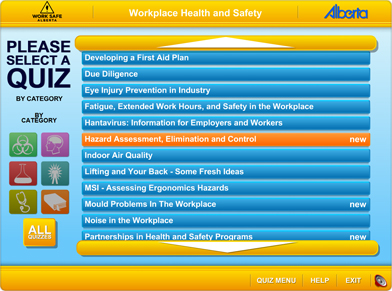Training Room 2: Hazard Identification, Assessment, and Control
Hazard Identification

Tom Schmucker/Hemera/Thinkstock
A job hazard analysis is an exercise in detective work. The goal is to discover the following:
• What can go wrong?
• What are the consequences?
• How could it arise?
• What are other contributing factors?
• How likely is it that the hazard will occur?
Watch and Listen
This is a short interactive learning activity from Work Safe Alberta. Follow the instructions and work your way through the following:
- Identifying Health and Safety Hazards
- Types of Controls
- Hazard Assessment & Control
- Check Your Understanding quizzes
Once you are done, you can complete a quiz on Work Safe Alberta for practice.

Used with permission Alberta Human Resources.
From this list of quizzes, choose the Hazard Assessment, Elimination and Control quiz from near the top of the list. Complete it, and challenge your teacher, a friend, or one of your classmates when you are done. You will need the person's e-mail address before you start.
Discover
This quiz from Work Safe Alberta is a good review of how to identify workplace hazards.
There are many workplace safety videos available on the Internet. You might try watching one of these:
"Think" is a video by a high school student that placed second in the Work Safe Alberta video contest in 2010.
These audio and video clips from Employment and Immigration promote safety.
Bloody Lucky is a safety awareness campaign. (Warning: Some of these videos are very graphic.)
The Edutainment/Awareness page at Employment and Immigration has many different video and audio clips.
Assignment
Explore these resources and use them to complete the following activity
(if these links are broken, you may need to search for these on the Internet):
- Employment and Immigration on Workplace Hazards or
- The Young Workers Zone at the Canadian Centre for Occupational Health and Safety.
Create a job hazard analysis for one of the following scenarios:
- filling a lawn mower with gasoline
- changing a ceiling light bulb
- cleaning out a rain gutter
- cutting a piece of wood with a handsaw
- mixing a pesticide/herbicide in a portable sprayer
- working around a deep fryer
- setting up either a computer monitor or workstation
In your analysis, you should include
- a specific description of the physical, biological, chemical, ergonomic, and psychosocial hazards associated with each scenario
- an explanation of how to prevent hazards in each scenario
- any general safe workplace practices that may apply
Here is an example checklist from the Canadian Centre for Occupational Health and Safety.
Save your document as "hazard analysis."